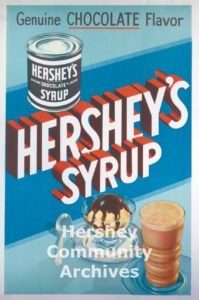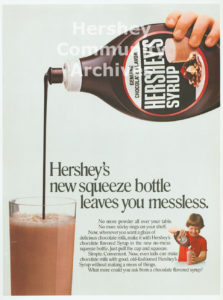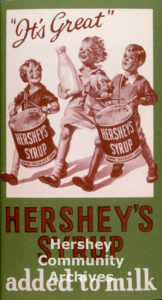Hershey’s Syrup

Hershey Chocolate Company first began producing chocolate syrup for commercial use in 1926. However work on a formula for syrup had begun a few years earlier. There was an experimental kitchen at the old Hershey Industrial School (today Milton Hershey School). Chance Phillips, a long time employee began working for Hershey Chocolate in 1914 recalled that in the experimental kitchen he “developed all the batches [of syrup] for Mr. Hershey’s official approval” around 1922 or 1923.
He [Mr. Hershey] would come up and say, “Well, what have we done today? I want it done this way.” Sometimes he saw that I was discouraged. “Well,” he would say, ’”that’s the way we do these things. You may make a hundred batches that don’t suit me. The next may be just the way I want. Don’t be discouraged.”
It wasn’t until 1926 that Hershey Chocolate Company began manufacturing and marketing syrup. Led by Chief Chemist Sam Hinkle, the factory’s Laboratory and Experimental Department worked long hours to develop the product of chocolate flavored syrup in cans. Building on the work Chance Phillips had completed a few years earlier, formulation of both a single and a double strength syrup was not difficult. Plans called for the chocolate syrup to be packaged in cans, but there were concerns that the canned product might ferment and spoil. Outside consultants were brought in. The company paid the sum of five thousand dollars to Mr. McGowan, a chemist, who advised that the syrup should not be heated above 180 degrees Fahrenheit, well below the boiling (and sterilizing) temperature of 212 degrees Fahrenheit. Fortunately the Company disregarded this advice and all syrups were at least brought to the boiling point in preparation.
When Hershey’s Syrup was first introduced it was marketed to commercial users (i.e. bakers, soda fountains, restaurants). It was marketed in two strengths: single and double. Single strength was marketed for use in soda fountain pumps for making carbonated beverages. Double strength was used for use as a topping and in milk drinks.
In late 1928 salesmen’s requests led the company to package single strength syrup for home use. It was first offered for sale in two sizes: 5 ½ oz and 18 oz metal cans. In 1934 the 18 oz. size was reduced to 16 oz and was marketed as a one pound can. Labels incorporated the iconic Hershey block letter design.
To help introduce the new product to consumers, Hershey Chocolate hired a public relations/marketing firm, N.W. Ayer & Son, to help with the launch. Hershey hired Caroline King to develop 12 recipes using syrup. The recipes and syrup samples were distributed to “home institutes” and magazines, including Good Housekeeping Delineator, People’s Home Journal, McCall’s Magazine, Women’s Home Companion, Liberty and Conde Nast publications. Initial results were positive and publications printed recipes and articles about Hershey’s new product.
Although Hershey Chocolate Company had been manufacturing its own metal containers for Hershey’s Cocoa since the factory opened in 1905, when Hershey began producing chocolate syrup, the company purchased the cylindrical cans. It wasn’t until 1956 that Hershey began manufacturing their own syrup cans. Howard Phillippy, a plant engineer, led the effort to install the needed machinery. In his oral history interview, he explained how Hershey Chocolate factory began manufacturing its own syrup cans:
I well remember the way we got into making the syrup can was, at that time…I was in the design area. Whereas we never bought anything without it going through the formal purchasing department, I was pretty free, and if there was anything engineering-wise, production equipment-wise, the sales reps would invariably be referred to me. So one of these sales representatives working for Baldwin-Lima- Hamilton can-making machinery company had stopped in because they knew that Hershey was making their cocoa cans. Hershey was making cocoa cans before my time. We did buy improved machinery during my tenure there, but they were making cocoa cans before my time, for years back.
Now then, this can machinery representative, knowing that Hershey made their own cocoa cans, came around. He just wanted to see was there anything that he could offer from the standpoint of equipment improvement or did we need any help and that sort of thing. It was while he was there, he learned that we are buying our syrup cans, and he asked, “Gee,” he said, “why wouldn’t you make your own?”
I said, “I don’t know. The subject never came up, not in my time, anyhow. I don’t know really why we aren’t.”
He said, “Well, how many cans do you make a year?”
Well, we were making–let me say it was 70 million cans by that time. He said, “If you make 20 million cans a year, it would pay you to make your own.”
And I just said, “Well, we have no idea. How many people would it take to operate? What kind of machinery do we need?”
He said, “I’ll give you a list of the machinery you would need and approximately what kind of attendants you’d need.”
He supplied me with that, and on that basis, I went to–Lou Smith was then my superior. He was VP of engineering. I went to Lou and we, together, saw the great possibilities in this thing. . . Earl Lehman was the comptroller of Hershey Chocolate at that time. I remember taking the figures of the cost of the machinery, the cost of the whole project up to him, and he ran it through the cost process, and I know he said, “My goodness, we can’t afford not to make these.” His figures that he came out with showed that we would realize the cost of the equipment in a year and a half. He was saying, “Gee, how long is it going to be to get delivery of the machinery?” It was like nine months or more. As I recall, going into the business, buying all the machinery, was less than $1 million at that time. [Laughter] It was about 1956. The cost of all of that machinery, for two lines of manufacturing of the entire syrup can, was less than $1 million. The cost savings would be realized in a year and a half.
Hershey continued to make its own syrup cans until 1979 when the factory began packaging Hershey’s Syrup in 24-ounce plastic bottles.

